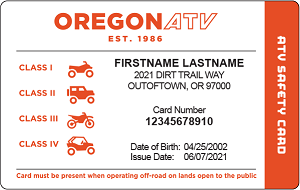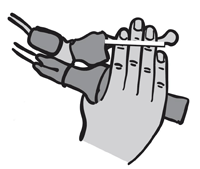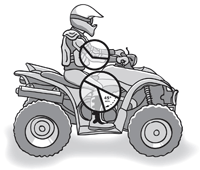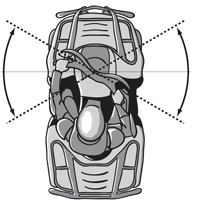
Oregon requires safety education for people operating ATVs on public land. A free online ATV safety education course is available online at
www.rideATVOregon.orgThe online course is designed to teach you about Oregon Laws, Safety riding practices and environmental awareness. You can print a 30-day temporary card and a permanent one will be mailed to you.
Out-of-state residents, who do not have a similar card in their state, need to get the Oregon ATV Safety Education Card.
Youth under the age of 16 need to complete a hands-on course in addition to the online course within 6 months.
Class I (quad, 3-wheelers) – ATV Safety Education Card required for all ages.
Class II (sand rail, trucks, SUVs) – Valid state-issued Driver’s License or Instruction Driver Permit required.
Class III (off-road motorcycle) – ATV Safety Education Card required for all ages.
Class IV (side by side) – Valid state-issued Driver’s License or Instruction Driver Permit. If under 16, an ATV Safety Education Card required unless they have Instruction Driver Permit.
If you are renting an ATV, you get a 30-day temporary card from the rental agency after reading and signing an ATV Rental Safety Checklist. Getting your free, permanent ATV Safety Education Card now may save you time at the rental agency.
Operators with a suspended or revoked driver’s license may not operate any ATV
For those age 16 and over
Take the free online course, available at www.RideATVOregon.org
For those under age 16
Youth under age 16 must complete two-steps in order to obtain an ATV Safety Education Card.
Step one is to take an approved online course. Once the online course is complete, the youth will receive an “Instructional Permit” that is good for 180-days so the youth can get riding experience and familiarity with the vehicle under the supervision of a parent or guardian. The youth can then proceed to step two which is to take a hands-on training or evaluation course. Note that the youth must have their 11-digit ATV Safety Education Card number to take a hands-on course.
- Step Two – Take a Hands-on Course
Once the youth has completed an approved online course, the youth will be given an “Instructional Permit” containing an 11-digit ATV Safety Education Card number. After the youth has gained some riding experience and is familiar with the vehicle, it’s now time to find a hands-on course.
Note: Hands-on Evaluation courses assess the skills of an operator who feels they have experience while Hands-on Training courses assume no previous experience or skill.
Visit our Hands-on Course Locator for available courses in your area. The average travel time to a hands-on course location is typically 1 to 2 hours. We do our best provide opportunities throughout the state. Note that course availability diminishes greatly during the late fall and winter months.
Hands-on Evaluation Courses
Hands-on Training Courses
- Class I (quad) and Class IV (side by side)
OSU/4-H – Oregon ATV Safety Youth Rider Endorsement Program www.oregonatvsafety.com
- Class I (quad) only
ATV Safety Institute (ASI) www.atvsafety.org
Please note new ATV Safety Institute (ASI) hands-on training course prerequisite. In addition to taking an Oregon approved online course (such as www.rideatvoregon.org) the student must also successfully complete ASI’s ATV E-Course prior to taking an ASI hands-on training course. The ASI E-Course requirement does not pertain to other hands-on training providers, only ASI.
- Class III (off-road motorcycle) only
MSF DirtBike School www.dirtbikeschool.org
All non-residents operating Class I (quad) and Class III (off-road motorcycle) vehicles in Oregon are required to take the online ATV Safety Course and carry an ATV Safety Education Card. They are exempt if they possess a card issued by another state or country.
Possessing an ASI or MSF training card does not qualify as a accepted state issued Safety card.
Current list of States that Oregon accepts their cards:
- Arizona
- Idaho
- Indiana
- Iowa
- Massachusetts
- Michigan
- Minnesota
- Montana
- New Hampshire
- New Mexico
- Pennsylvania
- Vermont
- Wisconsin
Adult Supervision is required for youth operators under age 16
By law, a supervisor is defined as a person who is at least 18 years of age, holds a valid ATV Safety Education Card, and is able to provide immediate direction and assistance to the youth.
Some of the worst accidents have been due to a lack of adult supervision. Adults are important to teach youth proper skills, make sure youth do not get out of control and provide assistance in case of an accident or vehicle breakdown.
- When riding on trails or the dunes, it is best if the adult leads and the youth follows. That way the youth can mimic the adult. This has the adult making decisions such as at intersections or coming upon other traffic. If possible, it is best to have a second adult behind all the youth.
- If you are in a youth riding area and the adult is not riding on an ATV, the youth needs to be within visual distance. The adult supervising must also have a safety card, even if they are not riding.
Class I (quad, 3-wheelers) – There is no minimum age, but youth must meet rider fit requirements.
Youths operating Class I (quad) ATVs that are too big for them are at serious risk of injury or death. Youth must meet all the following minimum physical size requirements (Rider Fit) in relationship to the vehicle:
- Brake Reach: With hands placed in the normal operating position and fingers straight out, the first joint (from the tip) of the middle finger must extend beyond the brake lever.

- Leg Length: When sitting and with feet on the pegs, the knees must be bent at least 45 degrees.

- Grip Reach: While sitting upright on the ATV with hands on the handlebars and not leaning forward, there must be a distinct angle between the upper arm and the forearm.
- Turning of Handlebars: The operator must be able to turn the handlebars from lock to lock while maintaining grip on the handlebars and maintaining throttle and brake control.

- Disabled operators are allowed to use prosthetic devices or modified or adaptive equipment to achieve rider fit for Class I or IV ATVs.
Class II (sand rail, trucks, SUVs) – Must be at least 15 years old with “driving privileges” (license or learners permit)
Class III (off-road motorcycle) – Must be at least 7 years old.
Class IV (side by side) – Operators under age of 16 must meet manufactures age recommendation. Therefore, youth can only operate youth machines.